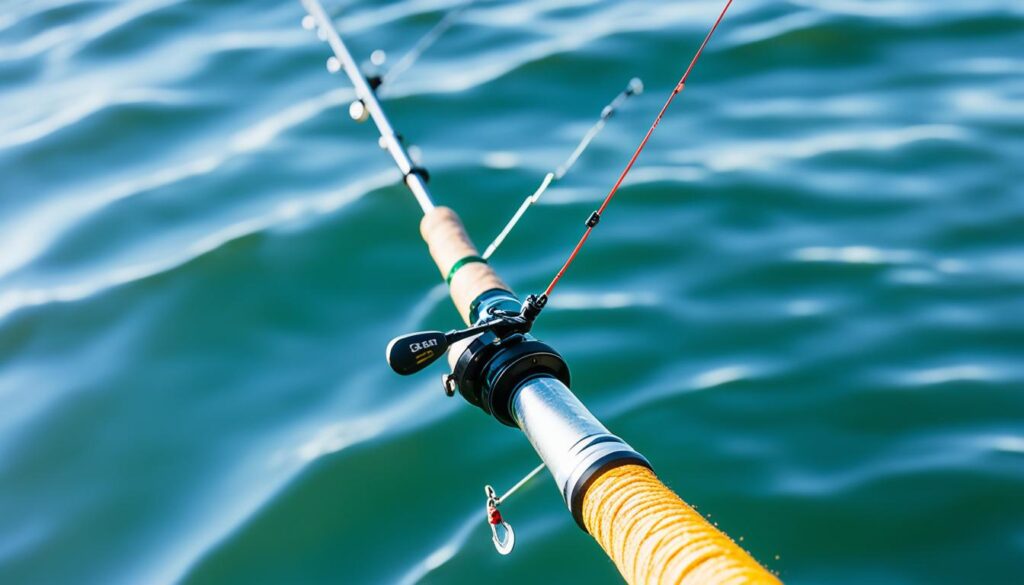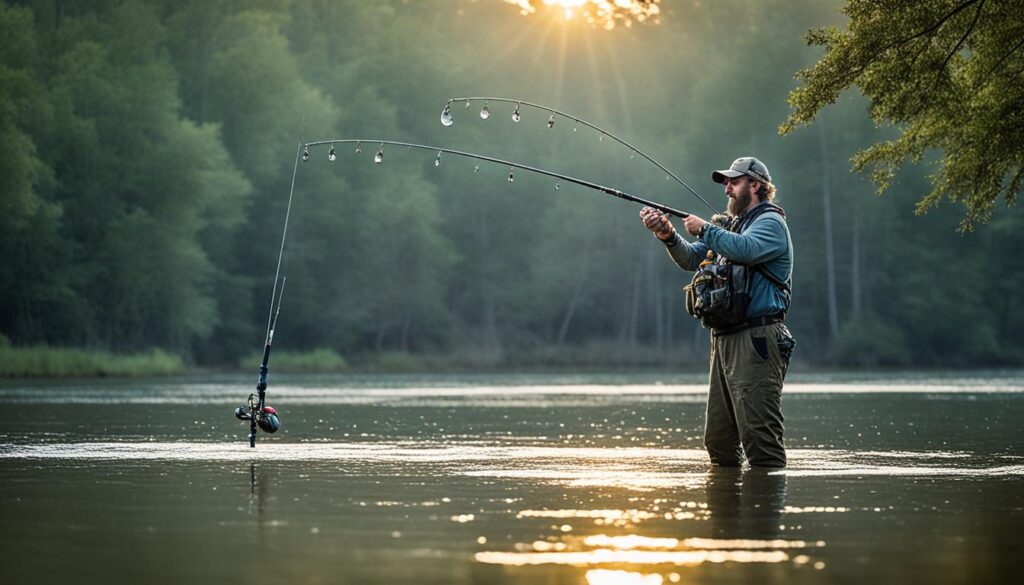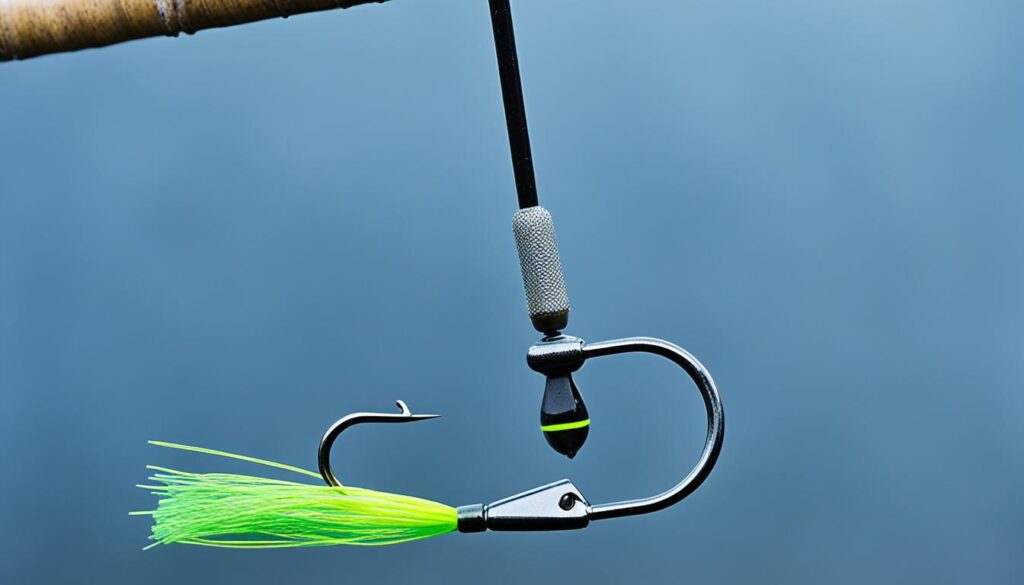The slip sinker rig, commonly called the Carolina rig, is an essential catfish rig for many anglers. It is versatile and can be used for fishing on anchor, drift fishing, fishing vertical, or on the bottom. This rig is effective for all three major species of catfish and can be used in various bodies of water. It is popular because it allows catfish to pull the line without meeting resistance from the sinker and allows the use of a bait clicker. The slip sinker rig is commonly used by catfish anglers and is considered a go-to setup.
Key Takeaways:
- The Carolina rig, known as the slip sinker rig, is famous for catfish fishing.
- It is versatile and can be used for various fishing techniques, including anchoring, drifting, and fishing on the bottom.
- The rig is effective for all three major species of catfish and can be used in different bodies of water.
- It allows catfish to pull the line without resistance from the sinker, providing a natural presentation of the bait.
- The Carolina rig is commonly used by catfish anglers and is considered a reliable setup for targeting catfish.
The Slip Sinker Rig: A Versatile Choice for Catfish Anglers
The slip sinker rig, also known as the Carolina rig, is one of the most popular catfish rigs among anglers. Its versatility and effectiveness make it a go-to choice for fishing all three major species of catfish.
Whether fishing on anchor, drift fishing, fishing vertical, or on the bottom, the slip sinker rig can be adapted to suit various catfishing techniques. It allows catfish to pull the line without encountering resistance from the sinker, increasing the chances of a successful hookup.
To set up a slip-sinker rig, you’ll need a few essential items, including a leader line, a hook, sinker, or weight. The leader should be long enough to handle aggressive catfish strikes and provide a swivel and sufficient abrasion resistance. It should also be strong, with a recommended 40—to 50 lb clear monofilament or fluorocarbon leader.
The hook choice will depend on the type of catfish you’re targeting and the bait you’re using. Treble hooks and circle hooks are commonly used for catfishing. The size of the swivel should match the size of the catfish you’re targeting. It’s also important to select the right sinker or weight for your rig. Egg sinkers or no roll sinkers are preferred for slip sinker rigs.
Remember: Choosing the best tackle for catfish is essential for a successful fishing experience. The right combination of leader line, hook, swivel, and sinker can significantly increase your chances of landing a catfish. Be sure to select a tackle that matches the size and behavior of the catfish you’re targeting.
With its simplicity, effectiveness, and versatility, the slip sinker rig has become a staple among catfish anglers. Whether you’re a seasoned angler or a beginner, mastering the Carolina rig setup and fine-tuning your tackle selection will give you an edge in catfishing.
Essential Tackle for Slip Sinker Rig Fishing
Having the correct tackle and equipment is crucial for success when it comes to slip-sinker rig fishing. Whether you’re Carolina rigging for catfish or employing other fishing techniques, here are the essentials you’ll need:
1. Leader Line
The leader line is an essential component of the slip sinker rig. It serves as a shock absorber during aggressive strikes and provides abrasion resistance. Opt for a 40—to 50-lb clear monofilament or fluorocarbon leader line to ensure its durability and strength.
2. Hooks
Choosing the right hooks is essential for catfish fishing. Depending on the type of catfish and bait you’re using treble or circle hooks are commonly recommended. These hooks are designed to increase hook-up ratios and enhance your chances of landing a big catch.
3. Swivel
Using a swivel ensures your line isn’t twisted while casting or retrieving. You can select a swivel size suitable for the size of the catfish you’re targeting. A reliable and sturdy swivel will prevent line breakage and allow smooth operation.
4. Sinkers
Egg sinkers or no roll sinkers are preferred for slip sinker rig fishing. These sinkers provide the necessary weight to keep your baited rig on the bottom and ensure it stays in place. The size of the sinker will depend on the depth and current conditions of the fishing location.
5. Additional Gear
Depending on your fishing technique and preferences, could you consider using additional gear to enhance the performance of your slip sinker rig? A peg float can suspend your bait off the bottom, making it more visible to catfish. A snagless drift fishing sinker can help prevent your rig from getting caught on underwater obstacles.
By having the correct tackle for slip sinker rig fishing, you’ll be well-equipped to master various fishing techniques and increase your chances of landing catfish successfully.
Step-by-Step Guide on Tying a Slip Sinker Rig
Learning how to tie a slip sinker rig, also known as the Carolina rig, is essential for targeting catfish effectively. Follow this step-by-step guide to rigging a Carolina rig:
- You can start by threading a slip sinker onto your main fishing line. The size of the sinker will depend on the current and depth of the water you are fishing in.
- Tie a small swivel onto the end of your main line using a secure knot, such as a Palomar knot. This swivel will act as a stopper for the sinker.
- Could you attach a leader line to the other end of the swivel? The length of the leader line can vary but is typically around 18-24 inches.
- Please choose an appropriate catfish hook and tie it to the leader line’s end using a solid knot, such as a clinch knot.
- Select your preferred catfish bait, such as live bait, cut bait, or a soft plastic lure. Attach the bait to the hook using the appropriate method.
- Optional: If you’d like, add beads or bumpers between the sinker and the swivel to protect your knot and line.
Once your Carolina rig is tied correctly, it’s time to cast your line and start targeting catfish!
“The Carolina rig is a versatile and effective setup for catfish fishing. By rigging a slip sinker rig, you can present your bait in a way that entices catfish while allowing them to take the bait without feeling resistance. This rig is particularly effective for targeting catfish in different fishing techniques and can be used in various water conditions.”
Pros and Cons of the Carolina Rig
| Pros | Cons |
|---|---|
| Allows catfish to take the bait without feeling resistance | Requires practice to master the rigging technique |
| Works well for both live and cut baits | Can be more challenging to fish in heavy vegetation |
| Effective in different fishing techniques, such as casting, dragging, and slow dragging | May require additional weight in strong currents |
| Provides a natural presentation of the bait | Requires adjusting leader length based on fishing conditions |
Mastering the Carolina rig opens up a world of opportunities for efficiently targeting catfish. With practice, you’ll become skilled at rigging this versatile setup and increase your chances of landing that trophy-sized catfish you’ve dreamed of.
Do You Need Beads and Bumpers for the Slip Sinker Rig?
Many instructions suggest using beads and bumpers in slip sinker rigs to prevent the weight from weakening the knot or breaking the line. While these additions can be helpful in certain situations, they are unnecessary for many applications. Experienced catfish anglers have used slip sinker rigs without beads and bumpers without experiencing line breaks or failed knots. However, it may be beneficial to use beads or bumpers in heavy currents or when using heavy sinkers. Ultimately, deciding to use beads and bumpers in a slip-sinker rig is up to your preference and fishing conditions.
Alternatives to the Slip Sinker Rig for Catfish Fishing

While the slip sinker rig is popular and versatile for catfish fishing, other rigs can be effective in different situations. Exploring alternative rigging techniques can help you adapt to specific fishing conditions and increase your chances of success. Here are three alternatives to the slip sinker rig:
The Three-Way Rig
The three-way rig is ideal for getting the weight and bait farther apart, allowing for more enticing movement in the current. This rig involves attaching a three-way swivel to your mainline and two leaders. One leader holds the sinker, while the other carries your bait. The three-way rig enables you to cover a larger fishing area and can be particularly effective when catfish are holding in deeper water or when you want to present different baits simultaneously.
The Carolina Rig
Although commonly used by bass anglers, the Carolina rig can also be effective for catching catfish. This rig presents a bait on the bottom without allowing the fish to feel the weight. It involves a sliding sinker positioned above a swivel, with a leader and hook trailing behind. The Carolina rig allows for a natural presentation and can be particularly effective when fish are finicky or when you want to cover larger areas while maintaining bottom contact. It’s a versatile option that gives you the freedom to experiment with different baits and fishing techniques.
The Floating Rig
If you’re fishing in muddy or muck bottoms, the floating rig can be a great alternative to the slip sinker rig. This rig keeps the bait off the bottom, maximizing visibility and reducing the chance of it getting lost in the muck. The floating rig consists of a bobber or float positioned above the bait, suspending it at a desired depth. This rig is commonly used for live or cut bait and can be effective for enticing catfish to strike in murky waters or areas with heavy vegetation.
The Versatility of the Carolina Rig for Catfish Fishing

The Carolina rig is a versatile rig that allows for a natural presentation of a soft plastic lure to catfish. It consists of a sliding weight connected to a swivel, with a leader and hook trailing behind. The smooth plastic bait moves lifelike by dragging the weight along the bottom, attracting catfish. The Carolina rig can effectively use various fishing techniques, including casting, dragging, and slow dragging. It is beneficial when fish are less aggressive and require a more natural presentation.
The Carolina rig offers catfish anglers a range of techniques to entice bites and maximize their catch rate. Here are some key catfishing methods that can be implemented with the Carolina rig:
- Casting: The Carolina rig is ideal for casting to specific areas where catfish might be hiding, such as structure, vegetation, or drop-offs. Cast the rig out and retrieve it slowly, steadily, allowing the bait to entice the catfish into striking.
- Dragging: This technique involves slowly dragging the Carolina rig along the bottom, mimicking the movement of prey. It effectively covers a larger area and entices catfish that are actively foraging.
- Slow Dragging: This is similar to dragging, but with an even slower and more subtle movement. Slow dragging the Carolina rig is particularly effective when targeting less aggressive catfish that require a more delicate presentation.
When rigging a Carolina rig, selecting the right soft plastic lure is crucial. Popular choices include baitfish imitations, creature baits, and crawfish imitations. Experimenting with different colors and sizes can help determine what the catfish are most actively interested in.
Overall, the Carolina rig is a versatile tool in the catfish angler’s arsenal. Its ability to present a natural bait in a lifelike manner attracts catfish in various fishing techniques and situations. Whether you’re casting, dragging, or slow dragging, the Carolina rig offers a reliable and effective means of targeting catfish.
Wrap-Up of Carolina Rig Fishing for Catfish
The Carolina rig, the slip sinker rig, is a versatile and practical choice for catfish fishing. By following these steps to tie a slip-sinker rig and understanding its benefits, you can increase your chances of success when targeting catfish. Whether you’re fishing for blues, channels, or flatheads, the Carolina rig provides a reliable option.
To maximize your catch rate, it’s essential to use the correct tackle, techniques, and baits. Choose a leader line made of 40 to 50-lb clear monofilament or fluorocarbon for its strength and abrasion resistance. Pair your leader line with a suitable hook, such as a treble hook or circle hook, depending on the catfish species and bait used. Don’t forget to use an appropriate swivel and sinker, like an- egg sinker or enroll sinker, to complete your Carolina rig setup.
Experiment with different catfish baits, such as live bait or a variety of scented soft plastics, to entice catfish to bite. Remember to drag the weight along the bottom to create a lifelike movement for your bait. Whether you’re casting, dragging, or slow dragging, the Carolina rig allows for a natural presentation that can attract even the pickiest catfish.
The Carolina rig has a versatile rigging option that can be adapted to different fishing techniques and conditions. By mastering the art of Carolina rig fishing for catfish and utilizing the proper methods and baits, you’ll have a greater chance of landing that trophy catfish. So gear up, head to your favorite catfish spot, and enjoy a successful catfishing experience with the Carolina rig!
FAQ
What is a slip sinker rig or Carolina rig?
The slip sinker rig, commonly referred to as the Carolina rig, is an essential catfish rig for many anglers. It is versatile and can be used for fishing on anchor, drift fishing, fishing vertical, or on the bottom. This rig is effective for all three major species of catfish and can be used in various bodies of water. It is popular because it allows catfish to pull the line without meeting resistance from the sinker and allows the use of a bait clicker.
What tackle do I need for slip sinker rig fishing?
To set up a slip sinker rig or Carolina rig, you will need specific tackle and equipment. The leader line should be 40 to 50 lb clear monofilament or fluorocarbon, the hook can vary depending on the type of catfish and bait being used, the swivel should be a size suitable for the size of catfish being targeted, and egg sinkers or no roll sinkers are preferred for the slip sinker rig.
How do I tie a slip sinker rig?
Tying a slip sinker rig is a straightforward process. Here is a step-by-step guide:
Should I use beads and bumpers in a slip sinker rig?
Many experienced catfish anglers have used slip sinker rigs without beads and bumpers without experiencing line breaks or failed knots. However, in heavy currents or when using heavy sinkers, it may be beneficial to use beads or bumpers. The decision to use beads and bumpers in a slip sinker rig is up to the angler’s preference and fishing conditions.
Are there any alternatives to the slip sinker rig for catfish fishing?
Yes, there are other rigs that can be effective in different situations. The three-way rig is ideal for getting the weight and bait farther apart, the Carolina rig presents a bait on the bottom without allowing the fish to feel the weight, and the floating rig keeps the bait off the bottom for maximum visibility.
How versatile is the Carolina rig for catfish fishing?
The Carolina rig is a versatile rig that allows for a natural presentation of a soft plastic lure to catfish. It can be effective in various fishing techniques, including casting, dragging, and slow dragging. The rig is particularly useful when fish are less aggressive and require a more natural presentation.
What should I know about Carolina rig fishing for catfish?
Carolina rig fishing for catfish is popular and effective. With the right tackle, techniques, and baits, you can increase your chances of success when targeting catfish. The slip sinker rig, also known as the Carolina rig, is versatile and can be used in different fishing techniques. It allows catfish to pull the line without resistance from the sinker and is suitable for various types of catfish baits.
